Columnist Pauline Jakober discusses what she believes will be big in paid search in 2016, with a look back at some of this past year’s biggest developments.
Please visit Marketing Land for the full article.
Powered by WPeMatico

Tips, Expertise, Articles and Advice from the Pro's for Your Website or Blog to Succeed
Columnist Pauline Jakober discusses what she believes will be big in paid search in 2016, with a look back at some of this past year’s biggest developments.
Please visit Marketing Land for the full article.
Powered by WPeMatico

FullStory helps you build incredible online experiences by capturing every click, swipe, and scroll, then replaying sessions with pixel-perfect clarity.

TensorFire is a framework for running neural networks in the browser, accelerated by WebGL. Have a look at the powerful demo.

Share your biggest pain points or challenges you have with stock photos and images in this survey by the folks of Unsplash, the free high-res photography library.

A list of funny and tricky JavaScript examples. Compiled by Denys Dovhan and inspired by Brian Leroux’s talk at dotJS 2012.

A tutorial by Joseph Zimmerman on creating custom inputs with Vue.js.

Mailit is a drop-in microservice for sending emails over a REST API.

An amazing GIF-inspired wormhole demo by Louis Hoebregts.

A great article by Harry Roberts on stress-testing and identifying performance problems with third party resources.

Inspired by his daughters love for drawing, Jongmin Kim created this great app that visualizes pictures and letters in 3D.

Learn how to use resource priorities to improve the speed of delivery in a browser. By Ben Schwarz.

A great demo by Tero Parviainen.

A fun pixel font designed by Dávid Fucsku.

Mustafa Kurtuldu writes about how special design cases help shape the Material Design guidelines.

A guide on how to find the right typeface for your project by Fábio Duarte Martins.

Read how Kushagra Gour built the offline web playground, Web Maker.

A fantastic demo by Yoksel where you can build a wave path in SVG.

Wojciech Dobry shows how to use Looper for creating complex illustrations in Sketch.

Anthony Gore shows how to use a plugin that automatically minimizes render-blocking CSS in your Vue.js app.

A tutorial by Julien Benchetrit where he shows how to make a CSS only loader.

An insightful article by Joe Nelson on SQL isolation levels.

José Torre shares his thoughts on the latest discussion on criticism in the design community.

Some fine geometric vector shapes by Pixel Buddha.

Colorful animations in terminal stdout.
Collective #337 was written by Pedro Botelho and published on Codrops.
A few days ago we published a post on ProBlogger titled ‘Forget about Marketing: Concentrate on Blogging‘, which led to some interesting discussion on Twitter and in the comments.
I love the points author Nicholas Whitmore made in the post but I wanted to give a few thoughts, based on my own experience, on developing great content and promoting your blog.
Nicholas wrote some great arguments for focusing your energy on writing great content as the central way of growing your blog. He writes:
“When you write and publish awesome content on your blog, good things will come your way.”
I completely agree with this sentiment. As a blogger your #1 focus needs to be on producing content that is useful, engaging and of as high a quality as possible. Without it, all the marketing you might do will be wasted as you’ll just be directing people to something that is of no value to them.
As Nicholas goes on to write:
“When you write and publish boring content then spend hours on end building links to it, trying to force people to your website, good things will never come.”
Again, I agree with the sentiment expressed here.
However, on Twitter a discussion among some of my followers highlighted that some bloggers differ quite a bit on how much effort should be put into promoting a blog vs developing content for it.
While I think we all agree that the content on your blog needs to be of a very high focus, I’m also of the belief that if a blogger wants to grow their readership they also need to put effort into promoting that blog.
I like the idea of the marketing being taken care of by your visitors, if you have good enough blog post. In my experience, there are things you can do to promote your blog to help speed the process up, without compromising the quality of your posts.
In the early days of my own current blogs (here on ProBlogger and at dPS) I estimate I probably spent almost as much time writing content as I did working on growing the readership. In fact, I’m sure there were some weeks where I did spend considerably more time promoting my blog than writing content!
In short, I don’t see marketing and creating content as mutually exclusive – both are really important to me.
I recorded a webinar last year on this very topic with a load of tips in it. You can listen to it and see the slides here so I won’t rehash all of that but here’s a summary slide of the points I talked through.
You can see that my process actually talks about the content that you develop as being a part of finding readers for your blog (both in points 2 and 8). But by getting off your blog to promote what you do you are certainly able to significantly grow your blog.
For me, I’d say that the balance of creating content and promoting has changed over the life of my blogs over the years. This is probably partly because the life cycle of a blog but also due to my own personal circumstances and how much time I have available to work.
That said , I would always prioritise both on a daily basis… and would probably also add in that I prioritise other things too such as ‘engaging with readers/building community’ and also a focus upon ‘monetization’ (without which I can’t sustain what I do).
I’d love to hear how others get this balance right in your blogging?
Content Creation vs Content Promotion: Where is the Balance?
http://www.problogger.net/archives/2013/06/19/content-creation-vs-content-promotion-where-is-the-balance/
http://www.problogger.net/archives/category/miscellaneous-blog-tips/feed/
@ProBlogger» Miscellaneous Blog Tips
Blog Tips to Help You Make Money Blogging – ProBlogger
http://www.problogger.net/wp-content/plugins/podpress/images/powered_by_podpress_large.jpg
Many of us struggle silently with mental health problems and many more are affected by them, either directly or indirectly. It’s {Geek} Mental Help Week and we would like to help raise awareness with a couple of articles exploring these issues. – Ed.
We’ve all experienced that burnout moment. It’s that moment when we’ve got nothing left to give but keep trying anyway, when we’re left without much more than a shell to live in and motions to go through.

We’re fried and broken and wish desperately for our work to make sense, for our energy to come back, for things to be fun and as they were. In such moments all we want is for our work to feel like our work and not like torture.
The post Dealing With Loud And Silent Burnout appeared first on Smashing Magazine.
Dealing With Loud And Silent Burnout
http://www.smashingmagazine.com/2015/10/dealing-with-loud-silent-burnout/
http://rss1.smashingmagazine.com/feed/
Smashing Magazine
For Professional Web Designers and Developers
Powered by WPeMatico
Back in 2013, Google officially announced1 that it would begin to penalize websites that provide a faulty user experience on mobile devices. Specific examples included redirecting inner URLs to a home page when viewed in a mobile version of a website, as well as showing 404 errors to people attempting to access pages on mobile.
Toward the end of 2014, a Google spokesperson hinted that the mobile user experience would become a ranking factor2. In January 2015, a number of website owners received messages warning about mobile usability issues on their websites, linking to a section of Webmaster Tools where they could review the problems.
 3
3In this article, we’ll review how to flag mobile issues in Webmaster Tools, explain the most common issues and learn how to assess mobile usability problems on your website based on these flags. Because mobile usability has become a greater priority in Google’s ranking algorithm, ensuring an optimal mobile experience on every website has become more important than ever. See the search results below, where Google has marked a dedicated mobile website (DP Review) and a responsive website (CNET) as being mobile-friendly. The result for PC Magazine lacks this label.
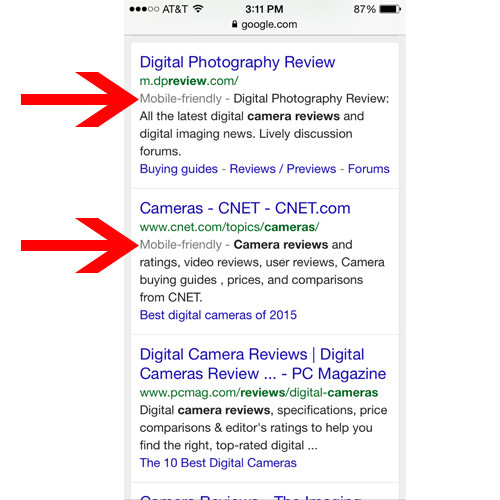 5
5Taking a look at each URL shows us clear reasons why DP Review and CNET earned mobile-friendly labels and why PC Magazine did not and ranks below the others. Not only does the PC Mag link not go to the proper mobile version of the website (which does exist), but it also delivers a popup promotion with a tiny close button that’s awkward to tap on mobile.
 7
7Setting aside the legitimate mobile issues, not only will people drop off of your website after a poor experience, but also your organic search traffic might decline because rankings can suffer in mobile search results. On the flip side, when you do improve a problematic website, you could see a vast improvement in organic search traffic, as we’ll see in the following example.
My agency built a new website to replace one that had many of the mobile problems we’ll review in this article. The original website contained a number of Flash elements, lacked any viewport configuration, and contained tiny text and touch elements when viewed on a mobile screen. The new website was built in a responsive format, eliminating these issues. Within two months of relaunching, the website saw a 44% increase in new users from organic Google searches on mobile devices, twice the increase seen on desktop. While a number of other factors certainly played a role, such as content refinement, the fact that mobile showed such a significant increase reflects the value Google ascribes to mobile usability.
In order to review mobile issues flagged on your website, you’ll first need to install Google Webmaster Tools. While many websites already run Webmaster Tools, some do not, and so here are brief instructions to set up. Navigate to the Webmaster Tools9 page, and log in with your Google account. You’ll see a field to enter your URL. Then, select “Add a Site.”
Next, you’ll need to verify the website. Webmaster Tools will show the various methods of doing so, including uploading an HTML file to your website, adding a meta tag or signing into your domain name’s provider. You can also verify via Google Analytics or Google Tag Manager if either code is in place on your website and you have access to the account. If you’re running a WordPress website, a plugin such as Yoast’s WordPress SEO will allow you to verify Webmaster Tools easily by copying and pasting a number from the meta tag into a field in the plugin.
After setting up Webmaster Tools on your website, you might not see any data in the interface for a few days. Submitting a site map10 could speed up the process of crawling and indexing your website.
You’ll find the “Mobile Usability” section under “Search Traffic” in the left navigation bar. This will show you what errors, if any, have been found on your website. Click any of the error categories to see specific URLs flagged for each.
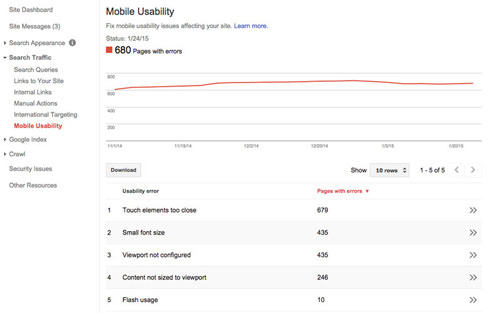 11
11Google shows mobile issues in six main categories:
To fix these issues, look at the flagged URLs and determine what edits need to be made.
Regarding “Flash usage,” any Flash elements will not render properly on most mobile devices. For example, when I try to access We Choose the Moon13 from an iPhone, it prompts me to download Flash to experience the website. Well, I obviously can’t install Flash on my iPhone, so I can’t experience this website at all on mobile.
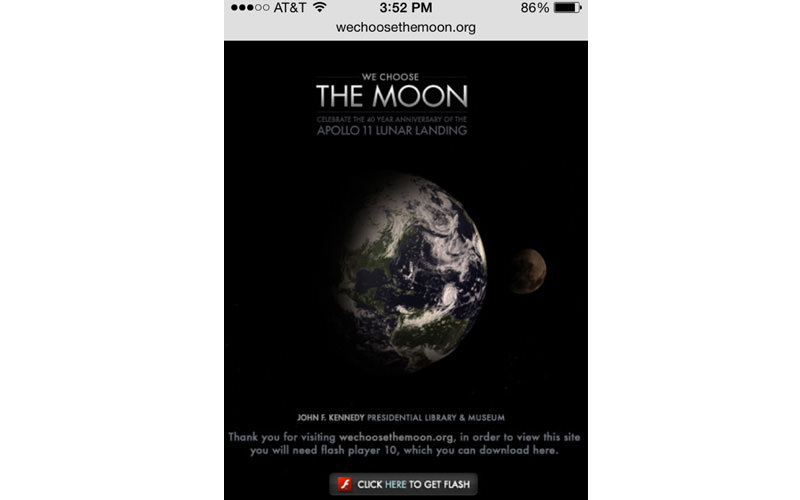 14
14Fixing this problem simply means restructuring the website to not include any Flash when served on a mobile device.
“Viewport not configured” means that the website is not scaling properly to the device’s size. See the website below, parts of which are cut off in small browsers.
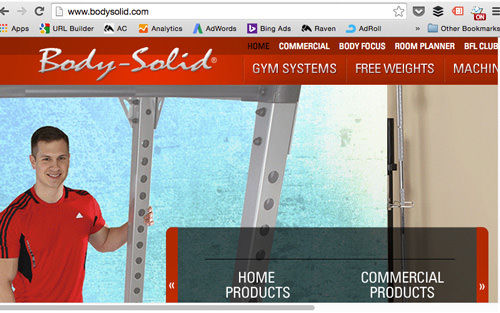 16
16Use the meta viewport tag to ensure that the height and width of the website change based on the size of the phone or tablet’s screen. Inserting the following code into the head of the website will cause it to resize and rearrange elements to fit various screen sizes.
<meta name="viewport" content="width=device-width, initial-scale=1">In this code, width=device-width will automatically size the width of the website to the size of the window in which it is being viewed. And initial-scale=1 will set the zoom level of the website to 100%, scaling the website to fill the window regardless of the screen’s size. With this attribute in place, content will reflow when the phone or tablet is flipped from vertical to horizontal orientation.
“Fixed-width viewport” refers to pages that are set up to show at a specific pixel width. This is problematic when a website does not properly scale to an unexpected screen size. So, utilizing device-width in the viewport meta tag, as in the previous example, will enable the website to scale based on any device’s screen size.
 18
18For instance, note how the navigation cuts off on the right side of Anthem’s website, shown in the screenshot above. This website includes the viewport meta tag but uses it to define a specific width.
<meta name="viewport" content="width=1100" />Replacing width=1100 with device-width would cause the website to scale to the width of the browser, fixing the issue. Of course, the developer would likely want to address issues with how elements on the website adapt to changes in size, as well.
“Content not sized to viewport” indicates that the users with small browsers need to scroll from side to side to view elements (as in both the fitness and Anthem examples). This can prove annoying, especially on a phone. Replacing absolute positioning with relative positioning in the CSS would likely help to fix this problem. For example, note how elements in the website below are side by side in a larger browser but stack on top of each other when the browser is smaller.
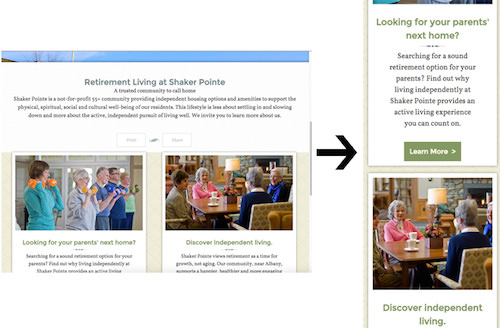 20
20“Small font size” flags text too small to easily read on a page. This can occur both from fonts that are too small as well as from insufficient vertical spacing between text. To avoid this, Google recommends22 starting with a base size of 16 CSS pixels and modifying up or down from there.
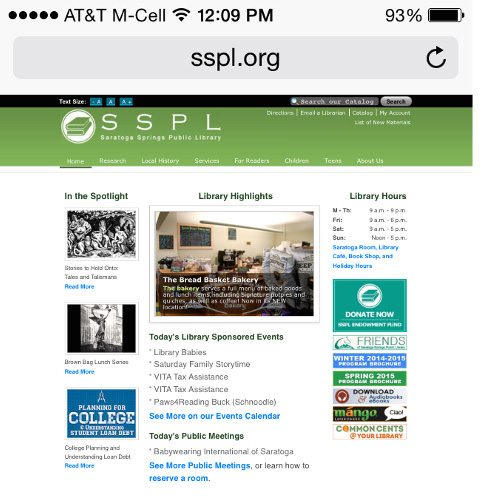 23
23“Touch elements too close” indicates that a user might have trouble tapping a specific button, navigation element or form field if it’s too small and jammed next to other clickable elements. This problem can cause frustration because a user might select a different button than intended. For example, see how several links in the following image are stacked close together, making it difficult to select a particular one on a phone.
 25
25To fix this problem, put enough space between buttons and links so that even on the smallest devices users will not have trouble selecting one. Adequate spacing is least at least 7 millimeters or 48 CSS pixels27 for these elements. Tweak this spacing to ensure that users do not encounter annoyances on a mobile device. In addition, think about what elements you will actually need to show phone users. In the example shown above, these users likely wouldn’t need to see all of the links and could have a much simpler experience with a few important links.
In the example shown earlier, I took a closer look at URLs flagged for “Flash usage.” I found that several of these pages include blog posts with embedded YouTube videos, whose content is served within an iframe (via the default embedding code). While these videos do show up as Flash at times, such as when viewed on a desktop page, they appear in HTML5 format on phones, playing with no problem. Ironically, even though it owns YouTube, Google has not picked up on the fact that YouTube changes the format of videos served when embedded on websites, depending on the device.
So, be sure to actually check the flagged pages to see whether issues are indeed legitimate. Keep in mind that Google’s automated crawling might not always show 100% accurate results. Although you can’t keep warnings about these pages from showing up, you could select an issue and choose to recheck the live version. Over time, Google will likely refine its methods for testing to filter out false flags.
On the other hand, don’t expect Google to pick up all potential problems with mobile usability. Just because you don’t see any errors, your website might not necessarily appear perfectly on all mobile devices. Test your website thoroughly across multiple devices and browsers to ensure a positive experience with website speed, appearance and interactivity.
Keep an eye on mobile metrics in Google Analytics to find potential usability issues. A key report to watch is found in “Audience” → “Mobile” → “Overview,” showing data for mobile, tablet and desktop traffic and engagement. For example, watch to see whether a high percentage of users on mobile devices are bouncing, especially if this number is much higher than for the desktop. Also, look at the average session duration for mobile devices to see whether the experience seems abnormally short or long. Overly brief or lengthy time spent on a website could indicate that people are either leaving right away out of frustration or are confused, taking too long to find what they wanted.
In addition, use heatmapping tools such as CrazyEgg28 and HotJar29 to analyze website usage beyond what Google’s tools can tell you. All of these tools show how users interact with mobile specifically, including data such as where they click and how far they scroll. This data could reveal problems, such as users not scrolling all the way to the bottom on a long mobile page or not clicking buttons that appear too small on a mobile device.
For instance, based on heatmap data, we discovered that few users on phones were scrolling down to a form on a particular landing page. We then added functionality to allow users to tap a button at the top, causing the page to immediately scroll to the form. Afterward, we experienced an increase in form submissions.
Google Webmaster Tools is a helpful starting point for analyzing mobile issues on your website. If you receive warnings, don’t ignore them. Take time to look at the problems and identify opportunities to improve your website’s mobile usability. Ultimately, your goal is to make the website the best experience possible for mobile users, not just to obsess over your rankings in Google. However, Google will reward positive user experiences.
viewport meta tag on your website.(da, al, ml)
The post Assessing Mobile Usability With Google Webmaster Tools appeared first on Smashing Magazine.
Assessing Mobile Usability With Google Webmaster Tools
http://www.smashingmagazine.com/2015/03/25/assessing-mobile-usability-google-webmaster-tools/
http://www.smashingmagazine.com/feed/?#
Smashing Magazine
For Professional Web Designers and Developers
Powered by WPeMatico
There are SO MANY popular premium WordPress themes available in the market these days. This, of course, is no surprise because hundreds of thousands of people are looking for awesome, fully-functional, great-looking WP themes like...
The post The Most Popular Premium WP Themes in 2017 appeared first on 85ideas.com.